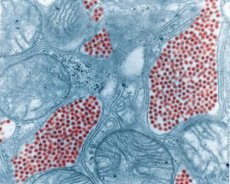Medical expert of the article
New publications
Omsk hemorrhagic fever virus
Last reviewed: 04.07.2025

All iLive content is medically reviewed or fact checked to ensure as much factual accuracy as possible.
We have strict sourcing guidelines and only link to reputable media sites, academic research institutions and, whenever possible, medically peer reviewed studies. Note that the numbers in parentheses ([1], [2], etc.) are clickable links to these studies.
If you feel that any of our content is inaccurate, out-of-date, or otherwise questionable, please select it and press Ctrl + Enter.

Omsk hemorrhagic fever is an endemic infectious disease transmitted through the bites of ticks of the genus Dermacentor and sometimes by infection through direct and indirect contact with muskrats or water rats. It is registered only in some forest-steppe areas of the Omsk and Novosibirsk regions. An increase in the incidence is noted in May-June, then in September-October. The virus was isolated and studied in 1947 by M. P. Chumakov. The incubation period is from 2 to 5-7, sometimes up to 10 days. The onset is acute: chills with a temperature of up to 39-40 ° C, headache, weakness. From the 3rd-4th day, hemorrhagic symptoms develop - fine-point rash, bleeding (nasal, gastrointestinal, uterine). Bronchitis and pneumonia are also noted. The fever lasts from 5 to 15 days. and usually ends with recovery, against which a second wave of the disease is sometimes observed.
Immunity
After togavirus and flavivirus infections, immunity is maintained for a long time, and in some cases, stable lifelong immunity is formed. In endemic areas, it can be formed in people as a result of inapparent infection. The number of people with antibodies to local arboviruses increases with age. During recovery, antihemagglutinins appear in the blood first, on the 6th-7th day, complement-fixing antibodies are detected by the end of the 2nd week, and virus-neutralizing antibodies, first IgM, then IgG, are detected on the 3rd-4th week. A feature of tick-borne encephalitis is the duration of IgM production, which is detected even 3-6 weeks after the onset of the disease.
Laboratory diagnostics of Omsk hemorrhagic fever
Virological, biological and serological methods can be used to diagnose alpha-virus and flavivirus infections. Material from a sick person - blood (during viremia), cerebrospinal fluid (during the development of meningoencephalitis signs), autopsy material (brain tissue) - is used to infect kidney cell cultures and chicken embryo fibroblasts, infect chicken embryos in the allantoic cavity and intracerebral infect white mice. In tissue cultures, the virus is detected by the cytopathic effect, plaque formation, hemadsorption and hemagglutination reactions. Viruses are typed in the RSC, RTGA, as well as using the neutralization reaction on mice or in a cell culture.
In the serological method, virus-specific antibodies in paired patient sera can be detected using the RSC, RTGA, and also the neutralization reaction on mice or in cell culture. These reactions are considered positive with a fourfold increase in the antibody titer. According to the degree of specificity to the etiologic agent, antibodies are arranged in the following sequence: virus-neutralizing, complement-fixing, antihemagglutinins (in descending order).
Treatment of Omsk hemorrhagic fever
Specific treatment for Omsk hemorrhagic fever has not been developed; symptomatic therapy is limited. Data on the use of interferon are contradictory; assessment of its therapeutic effect is difficult due to the small number of observations. Vaccines are used to prevent some flavivirus infections. For example, a formalin-inactivated culture vaccine from the Sof'in or 205 strains is used to prevent spring-summer tick-borne encephalitis in Russia. Gamma globulin obtained by hyperimmunization of horses is used to treat and prevent this disease. A live attenuated vaccine from strain 17D grown in a chicken embryo is used to prevent yellow fever.


 [
[